 TRIZ/USIT Paper: TRIZ/USIT Paper: |
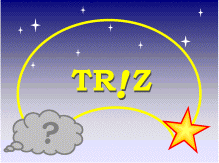  
|
USIT Solution Generation Methods
(Extended Version) - Simplified System by the Reorganization of TRIZ Solution Generation Methods |
Toru Nakagawa (Osaka Gakuin Univ.),
Hideaki Kosha and Yuji Mihara (Fuji Photo Film Co., Ltd., Japan),
Sept. 9, 2002 |
Extended Verstion of the Appendix to "Reorganizing TRIZ Solution Generation Methods into Simple Five in USIT"
ETRIA World Conference: TRIZ Future 2002, Strasbourg, France, Nov. 6-8, 2002 |
[Posted in Japanese on Sept. 18, 2002]
English translation: Mar. 9, 2003. [Posted in English on Apr. 3, 2003 ] [Note added: Dec. 22, 2012] |
For going back to Japanese pages, press

buttons.
Editor's Note (Toru Nakagawa, Sept. 18, 2002) (Translated into English on Mar. 8, 2003)
This document was originally prepared in Japanese during the process of the study presented at the ETRIA World Conference held on Nov. 6-8, 2002. A shorter form of this document was published in English as the Appendix of the paper:
"Reorganizing TRIZ Solution Generation Methods into Simple Five in USIT", Toru Nakagawa, Hideaki Kosha and Yuji Mihara, ETRIA World Conference 'TRIZ Future 2002', held at Strasbourg, France on Nov. 6-8, 2002; posted here in "TRIZ Home Page in Japan" on Nov. 19, 2002.
"USIT Solution Generation Methods (Full Version) -- Simplified System by the Reorganization of TRIZ Solution Generation Methods", Toru Nakagawa, Hideaki Kosha and Yuji Mihara, Appendix to the paper listed above; posted here in "TRIZ Home Page in Japan" on Nov. 19, 2002.
Abstract of the above paper is quoted below:
As Solution Generation methods, TRIZ has provided a large number of techniques
and principles: 40 Principles of Invention, 76 Standards of Inventive Solutions,
Trends of Evolution of Technological Systems, Separation Principle, etc.
This shows the richness in TRIZ, but also makes pitfalls of difficulty
and confusion. In the present study all these TRIZ methods are reclassified
in the framework of USIT (Unified Structured Inventive Thinking).
USIT has only five Solution Generation Methods: i.e. Object Pluralization,
Attribute Dimensionality, Function Distribution, Solution Combination,
and Solution Generalization Methods. It is remarkable that the huge
variety of TRIZ methods are smoothly mapped onto these five USIT methods.
The USIT Solution Generation Methods are now enhanced much with TRIZ-origin
methods and have clear guidelines. Thus the present work has reorganized
TRIZ into a much simpler yet more effective process for problem solving:
namely, USIT.
The present document shows the results of the work, in the form of "the Reorganized System of the Whole TRIZ Solution Generation Methods" and at the same time "the Full System of USIT Solution Generation Methods". The descriptions of various TRIZ solution methods (at their submethod levels) are maintained here,in the actual form we used them during the reorganization work.
We used the reference sources of TRIZ tools (and of Sickafus' Heuristics) as listed below. [Note that the outlines of these referenced methods are now accessible in separate pages under the "Index of TRIZ and USIT Methods" 
 ; you may click the items bellow.]
; you may click the items bellow.]
[P] TRIZ '40 Inventive Principles' 

[Yuri Salamatov, "TRIZ: The Right Solution at the Right Time", Insytec, 1999.]
[S] TRIZ '76 Inventive Standards' 

[Yuri Salamatov, "TRIZ: The Right Solution at the Right Time", Insytec, 1999]
Description of the Standards are simplified with the help of Mann's Textbook (2002). See: Outline of Mann's Inventive Standards. 
 [T] TRIZ 'Trends of Evolution of Technological Systems'
[T] TRIZ 'Trends of Evolution of Technological Systems' 

[Darrell Mann, "Hands-On Systematic Innovation", CREAX, 2002]
[H] Sickfus' Heuristics 

[Ed Sickafus, "Unified Structured Inventive Thinking", Intelleck, 1997]
[Note (Toru Nakagawa, Dec. 19, 2012): TRIZ Tools, including 40 Inventive Principles, 76 Inventive Standards, and Trends of System Evolution, were all developed originally by Mr. Genrich Altshuller (Ref. G.S. Altshuller: "Creatrivity as an Exact Science!", Gordon & Breach Science Publishing, NewYork, 1984; G.S. Altshuller: "To Find an Idea", Nauka, Novosibirsk, 1986 (in Russian). They are refered here in English textbooks (Salamatov's and Mann's) which are more commonly available in Japan.]
We wish people who learned TRIZ to read this document together with our paper mentioned above. TRIZ has accumulated a huge body of knowledge and has a wide variety of solution methods, which often make the learning difficult. Having studied TRIZ to some extent, please read our paper and this document; then you will be able to understand that the variety of TRIZ tools can work in a cooperative way. Though complex in the traditional form, TRIZ can be much easier in the present reorganized form.
We also wish people who learned USIT (without much of TRIZ) to read the present document. At the background of the USIT Solution Generation Methods, there is a rich basis of principles and solution methods obtained by TRIZ. Thus, studying TRIZ in its philosophy and with its knowledge bases, you will obtain much higher capabilities in applying USIT to your problem solving. [Note: We recommend the USIT beginners to read the "Simple Version" first, before you come to read this extended version.]
I am planning to maintain this document for the revisions and extensions in the future as a part of TRIZ/USIT Course Document (or TRIZ/USIT Knowledge bases). Using this document as a base, we are going to make links to various TRIZ/USIT methods and their application examples. Suggestions for improvement and contributions of information are welcome to the Editor via email.
Editor's Note (Toru Nakagawa, Mar. 31, 2003)
Please refer to the following articles as well:
(1) "Brief Guide to Nakagawa's TRIZ/USIT Articles", T. Nakagawa, posted on Feb. 18, 2003.
(2) "Usage of USIT Solution Generation Methods: A Simple and Unified System of TRIZ", T. Nakagawa, H. Kosha, and Y. Mihara, TRIZCON2003 (Mar. 16-18, 2003), posted on Apr. 3, 2003.
Editor's Note (Toru Nakagawa, Dec. 19, 2012)
In April 2003 I posted a set of 6 pages containing TRIZ tools (i.e., Inventive Principles, Inventive Standards, and Trends of System Evolution) with cross references among TRIZ and USIT tools. However, I withdrew them on Apr. 8, 2003, with my apology for my mishandling the copyright issues. After nearly 10 years, I have uploaded the whole set again today, with my statement of apology and thanks for the relevant authors. The pages are:
TRIZ and USIT Solution Generation Methods -- Cross References (Index top) 

(1) TRIZ: 40 Inventive Principles (according to Salamatov's textbook) 

(2a) TRIZ: 76 Inventive Standards (according to Salamatov's textbook) 

(2b) TRIZ: Inventive Standards (according to Mann's textbook) 

(3) TRIZ: Trends of System Evolution (according to Mann's textbook) 

(4) Sickafus' 21 Heuristics (according to Sickafus' USIT textbook) 

All these pages describe cross refererences among them and to the present USIT Solution Generation Methods (i.e. USIT Operators) in detail at the sub-method level. Thus their TRIZ --> USIT references are complementary to the USIT --> TRIZ references in the present page. I wish these pages be useful for understanding USIT and TRIZ further.
USIT Solution Generation Methods
USIT Solution Generation Methods (Contents. One-page Reminder) Sept. 18, 2002
| (1) Object Pluralization Method
a. Eliminate
b. Multiply into 2, 3, ..., inf.
c. Divide into 1/2, 1/3, ..., 1/inf.
d. Unify
e. Introduce or modify
f. Introduce from the Environment.
g. From solid to powder/liquid/gas
(2) Attribute Dimensionality Method
a. Deactivate a harmful
b. Activate a useful
c. Enhance a useful or suppress a harmful
d. Introduce a spatial attribute or
vary in space
e. Introduce a temporal attribute or
vary in time
f. Change the phase or the inner-structure
g. Attributes at the micro level
h. Properties of the system as a whole |
(3) Function Distribution Method
a. Reassign to a different Object
b. Divide the compound Functions
and assign them separately
c. Unify multiple Functions
d. Introduce a new Function
e. Vary the Function in space,
use space-related Functions.
f. Vary the Function in time.
g. Detection/measurement Function.
h. Enhance adapting/coordination/control
i. With a different physical principle
(4) Solution Combination Method
a. Combine functionally
b. Combine spatially
c. Combine temporally
d. Combine structurally
e. Combine at the principle level.
f. Combine at the super-system level
(5) Solution Generalization Method
a. Generalize/specify
b. Hierarchical system of solutions |
(1) Object Pluralization Method
Operate on each Object to 'Pluralize' it. 'Plural', in the sense of English language, means any number except 1; hence, 0, 2, 3, ..., infinity, 1/2, 1/3, ..., 1/infinity, etc. Besides, introduce a new/modified Object.
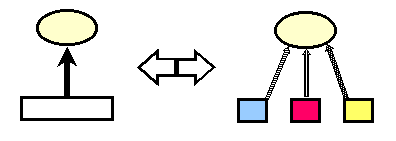
(1a) Eliminate the Object (into 0). (Simplification, Trimming)
| Eliminate the (subsidiary) Object in the system and reassign the Functions in the simplified system. |
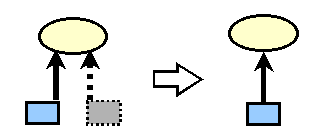 |
- In a system having a complex structure (or a difficulty), eliminate (or trim) the Object (or a subsystem) having a subsidiary role (or the problem). Assign the Function(s), if necessary, to some existing Objects (or a newly-introduced simpler Object) or else to the super-system.
-
Complex system ==> Elimination of non-key components ==> Elimination of non-key sub-systems ==> Trimmed system [T27. Trimming]
-
If the Object or a part of the Object becomes unnecessary/damaged/disturbing/harmful after performing its Function (or at its generation), eliminate it by use of decomposition/dissolving/evaporation/transportation/etc.
-
If a part of an object that has delivered its function had become unnecessary or undesired, elimenate it by dissolving, evaporating, etc. or modify so that the interfering property will cease to exist. [P34a. Reject and regeneration of parts]
-
Introduce a substance by decomposing the substances in the system or in the external environment. [S5-1.1.9 Introduction of substances under resticted conditions]
(1b) Multiply the Object (into 2, 3, ..., infinity).
| Multiply the Object into 2, 3, ... , and infinitely many, then modify the properties of the Objects (slightly or largely), and use them together. |
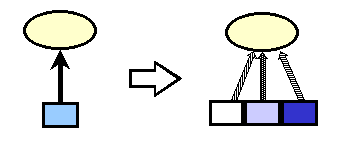 |
-
Multiply the Object into 2, 3, ..., and many, modify the properties of the (present and generated) Objects slightly (or largely), and use them together in the system.
-
Increase a number of nested objects. [P7b. Nesting]
-
Rearrange objects so that instead of one-storied arrangement a multi-storied arrangement can be achieved. [P17c. Another dimension]
-
Mono-system ==> Bi-system ==> Tri-system ==> Poly-system [T16. Mono-bi-poly (similar)]
-
Mono-system ==> Bi-system ==> Tri-system ==> Poly-system [T17. Mono-bi-poly (various)]
-
Multiply the Object into 2, 3, ..., and many, modify the properties of the Objects slightly (or largely), and combine them together into a complex Object, so as to obtain new properties and new functionality.
-
Merge two materials with different coefficients of thermal expansion. [P37b. Thermal expansion]
-
Use composite materials instead of uniform ones. [P40. Composites]
-
Besides the present Object, intorduce a new Object having different properties or even a new Object having opposite properties, and make the system have higher/more complex properties and functionality.
-
Similar components ==> Comonents with biased characteristics ==> Component plus negative component ==> Different components [T18. Mono-bi-poly (increasing differences)]
-
In case of using multiple of similar Objects, make the number extremely large (or infinite).
-
Take to extremes: from several to infinity in one dimension. [H17a. Take to extremes (0 to infinity)]
-
Take to extremes: from infinite in one dimension to infinite in two dimensions. [H17b. Take to extremes (0 to infinity)]
(1c) Divide the Object (into 1/2, 1/3, ..., 1/infinity).
| Divide the Object into multiple parts (1/2, 1/3, ..., 1/?), modify the parts (slightly, or differently for different parts), and combine them for using together in the system. |
 |
-
Divide the Objects into multiple parts and use them together. Guidelines for the division are:
- Divide it into mutually independent parts, such that each part is able to perform its own function better.
- Divide it into parts which are easy to assemble/disassemble.
- Divide it into parts, where specific part(s) are easy to replace/repair in case of their being broken, damaged, worn out, etc.
- Divide it into parts which are movable against one another.
- Divide it into parts so as to make the Object (or the system) flexible.
-
Divide your object into independent parts. [P1a. Segmentation]
-
Divide your object into parts so that some its part can be easily taken away. [P1b. Segmentation]
-
Divide your objects into parts capable of moving relatively each other. [P15b. Dynamicity]
-
If a part of the Object has undesirable properties, or if multiple parts or multiple functions of the Object have undersirable inter-relationship, divide the Object into multiple separated parts so as to eliminate the interferance and to enable the parts to have their own desirable properties and functionality.
-
Take away an interfering part of your object. [P2a. Taking away]
-
If some property of the object is undesirable, find out what part of the object is a carrier of the undesired property and separate it from the object. [P2b. Taking away]
-
If two functions are to be performed by the same object but this causes problems, divide the object into two parts. [P3c. Local quality]
-
Divide the Object into many (much) small parts and use them together as a group. Guidelines for the fine division are: [See (1g)]
- As the result of the fine division, make the fine parts easy to handle/transfer.
- As the result of the fine division, increase the surface area per weight and increase the interaction (among them or with other Objects).
-
Increase the degree of the object's fragmentation. [P1c. Segmentation]
-
Increase the segmentation of the Tool substance. [S2-2.2 Evolution of SFM]
-
Introduce a new field. [S5-1.2 Introduction of substances under resticted conditions]
(1d) Unify multiple Objects into one.
| Combine multiple inter-related Objects in the system and turn them into one Object with unified structure and functionality. |
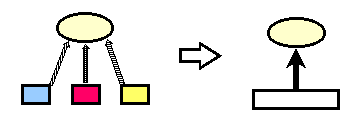 |
-
Combine similar or different multiple Objects together in space and in time, make their functional links closer, and unify them into one compound Object.
-
Merge identical parts or components of your object in space. [P5a. Combining]
-
Take multiple Objects performing differnt functions and generate a single versatile Object which can perform those functions in an unified way.
-
If you have two objects which deliver different functions, design a new single object that would be capable of delivering both functions. [P6. Universality]
-
Connect (extremely) many finely-divided Objects and form a single (flexible) continuous Object.
-
Take to extremes: to an infinite continuum. [H17c. Take to extremes (0 to infinity)]
(1e) Introduce a new/modified Object.
| Modify the present Object in its properties or structure, or else introduce a new-type of Object having new properties and functionality, so as to achieve desirable effects and functionality. |
 |
-
As for the source for obtaining the Object (i.e., resource) to modify/introduce, consider in the following order of priority as guidelines:
- The current target Object (for modification)
- Objects (except the target Object) present in the system
- Objects readily available around the system (i.e., in the super-system or in the environment)
- A new type of Object which can effectively use the Field (i.e., the form of energy) present in the system
- A new type of Object having different properties and functionality
-
Introduce a substance by decomposing the substances in the system or in the external environment. [S 5-1.1.9 Introduction of substances under resticted conditions]
-
Decompose one of the substances or the external environment to obtain substance particles. [S 5-5.1 Obtaining substance particles]
-
Combine elements from a lower structural level.[S 5-5.2 Obtaining substance particles]
-
Obtain substance particles by decomposing the nearest macro-level substances or by combining nearest micro-level substances. [S 5-5.3 Obtaining substance particles]
-
As for the position of the Object being modified/introduced, consider in the following order of priority as guidelines:
- Inside the Object (or the Object itself) being the target of the principal function (or the problematic effect) in the system
- On (or attached to) the Object being the target of the principal function (or the problematic effect) in the system
- Inside the tool Object (or the Object itself) being the tool (i.e., working element) of the principal function (or the problematic effect) in the system
- On (or attached to) the tool Object being the tool (i.e., working element) of the principal function (or the problematic effect) in the system
- Between the target Object and the tool Object of the principal function (or the problematic effect) in the system (for playing the role of mediator/media/barrier/protector/etc.)
- Inside/on/between other functionally-related Object(s) in the system
- Inside/on/between the Object(s) around the system (i.e., in the super-system or in the environment)
- Between the system and its environment (for playing the role of mediator/barrier/etc.)
-
Use an intermediate carrier to provide necessary actions if it is not possible to use existing objects or parts. [P24a. Intermediary]
-
Use flexible shells and thin films to isolate the object or its part from environment. [P30b. Flexible shells and thin films]
-
Use inert gases instead of usual ones. [P39a. Inert atmosphere]
-
Add neutral parts or additives to the object. [P39b. Inert atmosphere]
-
Insert an additive to form an internal complex S-Field Model system.[S1-1.2 Synthesis of SFMS]
-
Add an additive to form an external complex S-Field Model system. [S1-1.3 Synthesis of SFMS]
-
Apply a maximum action to the attached substance. [S1-1.7 Synthesis of SFMS]
-
Introduce a protective substance for achieving a selective action. [S1-1.8.1 Synthesis of SFMS]
-
Introduce a substance for selective enhancement of an action. [S1-1.8.2 Synthesis of SFMS]
-
For removing the harmful effect, introduce a third substance between the existing substances. [S1-2.1 Decomposition of SFMS]
-
For removing a harmful effect, introduce a new substance to draw the harmful effect away. [S1-2.3 Decomposition of SFMS]
-
As for the properties and functionality desirable to introduce as modified/new Object(s), guidelines are:
- In general, we want to introduce some properties/functionality which are insufficient/lacking at present and help realize the principal function of the system. Though such properties/functionality can range quite widely, the following items may be helpful as speciffic suggestions:
- Being able to achieve the same function (as far as the present problem concerns) with the present Object and being (much) less expensive and easier to handle than the present Object (such as cheap alternatives, copies, images, etc.)
- Enhancing and supplementing the principal function and being easier to handle/control
- Having different shape/structure, which introduces new type of properties/functionality
- Material having special properties, which introduce desirable properties/functionality in the system
-
Use rollers, balls, spirals. [P14b. Spheroidality]
-
If you need to undertake some actions with respect to unavailable, fragile, complicated, or dangerous object, use its simpler and cheaper copy. [P26a. Use of copies]
-
Instead of real objects, use their optical images (pictures, holograms). [P26b. Use of copies]
-
Use infrared or ultraviolet copies. [P26c. Use of copies]
-
Replace an expensive object with many cheap objects which deliver the same function. [P27. Cheap short-life instead of costly long-life]
-
Use porous coating. [P31b. Porous materials]
-
Use porous inserts. [P31c. Porous materials]
-
Use composite materials instead of uniform ones. [P40. Composites]
-
Use a ferro-magnetic substance and a magnetic field. [S2-4.1 Complex-forced SFMS (F-SFMS)]
-
Replace a substance with ferromagnetic particles, and apply a magnetic field. [S2-4.2 Complex-forced SFMS (F-SFMS)]
-
Use magnetic fluids. [S2-4.3 Complex-forced SFMS (F-SFMS)]
-
Introduce magnetic additives to form internal/external complex Ferromagnetic S-Field. [S2-4.5 Complex-forced SFMS (F-SFMS)]
-
Make the detection or measurement on a copy of the object. [S4-1.2 Change instead of measurment and detection]
-
Introduce an easily detectable additive for making the detection or measurement. [S4-2.2 Synthesis of measurement system]
-
Introduce into the environment an additive which generates an easily-detectable field, and detect or measure the new field. [S4-2.3 Synthesis of measurement system]
-
Introduce a ferromagnetic substance and a magnetic field to improve the measurement or detection. [S4-4 Transition to ferromagnetic measurement systems]
-
Introduce a copy of the substance. [S5-1.1.7 Introduction of substances under resticted conditions]
-
Introduce a substance which can be decomposed later. [S5-1.1.8 Introduction of substances under resticted conditions]
-
Add a substance which will disappear or become indistinguishable after it has fulfilled its function. [S5-1.3 Introduction of substances under resticted conditions]
-
Introduce new substances with special properties. [S Mann Cc4 (D2)]
-
Monolitic solid ==> Hollow structure ==> Structure with multiple hollows ==> Capillary/pporous structure ==> Porous structure with active elements [T2. Space segmentation]
-
As for the way of introducing modified/new Object, guidelines are:
- Arrange it in space so as to make its properties/functionality most effective.
- Arrange it in time so as to make its properties/functionality most effective.
-
Temporarily merge your object with another one that will provide the required action and then decompose them. [P24b. Intermediary]
-
If the object is porous, fill the pores with other substance, liquid or gas to achieve positive effect. [P31d. Porous materials]
-
Use a small quantity of a very active additive. [S5-1.1.4 Introduction of substances under resticted conditions]
-
Introduce a substance and voids in the foams or inflatable structures. [S5-1.4 Introduction of substances under resticted conditions]
-
Monolitic solid ==> Hollow structure ==> Structure with multiple hollows ==> Capillary/pporous structure ==> Porous structure with active elements [T2. Space segmentation]
(1f) Introduce an Object from the Environment.
| Environment here means anything which is around the present system and is available easily and inexpensively. (Though this is pointed out in (1e) as the resource for obtaining an Object for modification and newly introduction, the use of the Environment is apt to be overlooked but important.) |
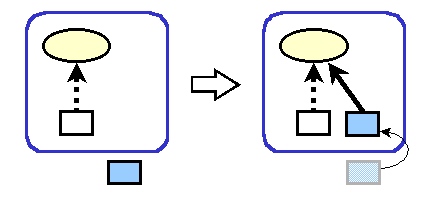 |
-
Use available resources or waste resources. [P25b. Self-service]
-
ntroduce a substance by decomposing the substances in the system or in the external environment. [S5-1.1.9 Introduction of substances under resticted conditions]
(1g) Replace a solid Object with a powder/fluid/liquid/gaseous Object.
Replace a solid Object in the system with powder Object, and further with fluid/liquid/gaseous Object, which may introduce characteristic properties such as fluidity, flexibility, operability, reactivity, etc. In relation to the replacement, a different kind of substance (or material) and a different mechanism of operation are often needed.
Note: This submethod (1g) may be regarded as an extension of submethod (1c) 'division of Objects', but is noted here because of the necessity of rather large change in the Object and in Functions. |
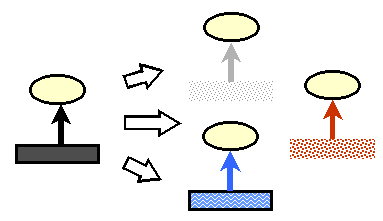 |
-
Instead of a solid object or its parts, use gases or liquids: inflatable and filled with liquids, air cushion, hydrostatic and hydro-dynamic. [P29. Pneumatic and hydraulic structures]
-
Instead of heavy three-dimensional structures use flexible shells and thin films. [P30a. Flexible shells and thin films]
-
Monolithic solid ==> Segmented solid ==> Particulate solid ==> Fluid ==> Segmented fluid (Foam, aerosol) ==> Gas ==> Plasma ==> Field ==> Vacuum [T4. Object segmentation]
(2) Attribute Dimensionality Method
Each Object (or substance) has different kinds of properties (where each category of properties is called 'Attribute'); thus we consider to newly use/stop using/enhance/fully use such properties. Especially, it is important to distribute/vary useful properties in space (including the inner structure) and in time in an effective way. Improving the properties of the whole system is an important target, too.

(2a) Deactivate/make irrelevant the harmful Attribute.
| Find any harmful properties in the system, and do not use them/make them irrelevant/turn them harmless/turn them into useful properties in the system. |
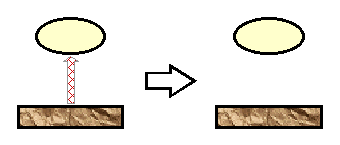 |
-
If some property of the object is undesirable, find out what part of the object is a carrier of the undesired property and separate it from the object. [P2b. Taking away]
-
Use harmful factors to achieve positive effects.[P22a. Turn the harm to one's good]
-
Eliminate a harmful factor by adding it with another harmful factor. [P22b. Turn the harm to one's good]
-
Amplify the harmful factor to such degree so that it would stop to bring harm to your object or environment.[P22c. Turn the harm to one's good]
-
Remove the adversity. [H15a. Adversity]
-
Change the adversity to an advantage. [H15b. Adversity]
(2b) Activate/involve a new useful Attribute.
| In the Object present in the system, start utilizing the Attribute (properties) (which has not been used yet) or introduce a new Attribute by modifying the Object. Further, if appropriate, replace the present Object with a new Object (or material) having such a useful Atribute and introduce a new function (or Field) which make the new properties effective. There are different sorts of Attributes. Consider the following types of Attributes: |
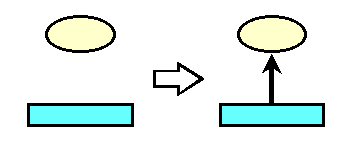 |
-
Use Attributes related to optical properties of Object; e.g. color, transparency, refractive index, reflective index, etc.
-
Change the color of the object, its part or environment. [P32a. Changing color]
-
No use of colour (monochrome) ==> Binary use of colour ==> Use of visible spectrum ==> Full spectrum use of colour [T21. Increasing use of colour]
-
Opaque construction ==> Partially transparent => Transparent ==> Active transparent elements [T22. Increasing transparency]
-
Use Attributes realted to thermal properties of Object; e.g. temperature, thermal extension ratio, thermal conductivity, specific heat, heat of evaporation/melting, etc.
-
Change the temperature of the object or environment.[P35d. Change of physical and chemical parameters]
-
Use thermal expansion or contraction of materials. [P37a. Thermal expansion]
-
Merge two materials with different coefficients of thermal expansion. [P37b. Thermal expansion]
-
Use Attributes related to mass and weight; e.g. weight, density (specific weight), mass distribution, etc.
-
Introduce a substance and voids in the foams or inflatable structures. [S5-1.4 Introduction of substances under resticted conditions]
-
102 ==> 101 ==> 100 ==> 10-1 ==> 10-2 ==> 10-3 ==> 10-4 ==> 10-5 ==> 10-6 ==> 10-7 ==> 10-8 ==> 10-9 ==> ... [T7. Decreasing density]
-
Use Attributes related to size and shape of the Object; e.g. length, area, volume, shape, etc.
-
If your object has symmetrized shape, make it asymmetrical. [P4a. Asymmetry]
-
If your object is asymmetrical, increase the degree of asymmetry. [P4b. Asymmetry]
-
Use rollers, balls, spirals. [P14b. Spheroidality]
-
Symmetrical system ==> Partial asymmetry ==> Matched asymmetry [T8. Increasing asymmetry (to match external asymmetry) ]
-
Use Attributes related to the surface, structure, and inner structure of the Object
-
Instead of heavy three-dimensional structures use flexible shells and thin films. [P30a. Flexible shells and thin films]
-
Monolitic solid ==> Hollow structure ==> Structure with multiple hollows ==> Capillary/pporous structure ==> Porous structure with active elements [T2. Space segmentation]
-
Smooth surface ==> Surface with rib protrusions ==> 3D roughened surface ==> Roughened surface + active pores [T3. Surface segmentation]
-
Use Attributes related to mechanical properties of Object; e.g. flexibility, strength, hardness, vibrational characteristics (resonance frequency, etc.), etc.
-
Change the degree of flexibility of the object. [P35c. Change of physical and chemical parameters]
-
Use resonance in all or part of the system and detect the change in the resonance frequency. [S4-3.2 Improvement of measurement systems]
-
Attach something in the environment to the system and use changes in it’s resonant frequency to make the measurement. [S4-3.3 Improvement of measurement systems]
-
Use Attributes related to electrical properties of Object; e.g., electirical conductivity, electrical capacitance, electirc charge, voltage, etc.
-
Use Attributes related to magnetic and electro-magnetic properties; e.g. magnetism, magnetic succeptibility, etc.
-
Use a ferro-magnetic substance and a magnetic field. [S2-4.1 Complex-forced SFMS (F-SFMS)]
-
Replace a substance with ferromagnetic particles, and apply a magnetic field. [S2-4.2 Complex-forced SFMS (F-SFMS)]
-
Use ferromagnetic substances with a porous structure. [S2-4.4 Complex-forced SFMS (F-SFMS)]
-
Add ferromagnetic elements to the external environment and use a magnetic field. [S2-4.6 Complex-forced SFMS (F-SFMS)]
-
Use Attributes related to chemical properties of Object; e.g. material, composition, concentration, chemical reactivity, dissolving power, etc.
-
Make interacting objects of the same material or the material with identical properties.[P33. Homogeneity]
-
Change concentration or composition of the object. [P35b. Change of physical and chemical parameters]
-
Replace regular air with enriched air. [P38a. Strong oxidizers]
-
Replace the enriched air with pure oxygen. [P38b. Strong oxidizers]
-
Ionize air or oxygen. [P38c. Strong oxidizers]
-
Use ozonized oxygen. [P38d. Strong oxidizers]
-
Use ozone. [P38e. Strong oxidizers]
-
Use inert gases instead of usual ones. [P39a. Inert atmosphere]
-
Add neutral parts or additives to the object. [P39b. Inert atmosphere]
-
Use Attributes related to the properties of physical change (i.e. phase transition) and chemical change of the Object.
-
Introduce a substance which can be decomposed later. [S5-1.1.8 Introduction of substances under resticted conditions]
-
Add a substance which will disappear or become indistinguishable after it has fulfilled its function. [S5-1.3 Introduction of substances under resticted conditions]
-
Employ a phase transition for improving the effectiveness of the substance. [S5-3.1 Use of phase transitions]
-
Make use of ‘transformable’ elements of substances. [S Mann Da6 (D3)]
-
Use Attribute related to special/functional properties of the Object; e.g. energy conversion, information conversion, etc.
-
Introduce new substances with special properties. [S Mann Cc4 (D2)]
-
Use substances with special properties and add an associated field to use those properties. [S Mann Ce3 (D2)]
-
Passive material ==> One-way adaptive material ==> Two-way adaptive material ==> Fully adaptive material [T1. Smart materials]
-
Convert energy or information from one form to another; e.g., sensors/transducers. [H21. Transduction ]
-
Use Attribute related to the operational properties of Object/System, which support the function of the system in a general sense; e.g. operability, controllability, manufacturability, etc.
-
Insert an additive to form an internal complex S-Field Model system. [S1-1.2 Synthesis of SFMS]
-
Enhance an existing or add a new field to provide an easily detectable parameter related to the parameter required to be measured or detected. [S4-2.1 Synthesis of measurement system]
-
Use a small quantity of a very active additive. [S5-1.1.4 Introduction of substances under resticted conditions]
(2c) Enhance the useful Attribute or suppress the harmful Attribute.
| Enhance the useful but insufficient Attribute or suppress the harmful/excessive Attribute. The same kinds of Attrributes are handled as used in the previous submethod (2b). |
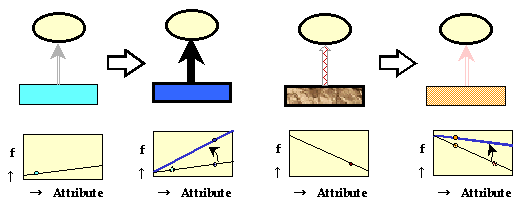 |
-
Redesign the Attributes of the Objects, their parts, or the Environment, in a way such that they satisfy the required/desirable conditions and perform the required/desirable Functions. It may often be necessary to modify/introduce an Object and/or to modify/introduce a Function.
-
Redesign your object and environment so that each part of the object must be in conditions proper for operation. [P3d. Local quality]
(2d) Introduce/enhance a spatial Attribute or distribute/vary in space a harmful/useful Attribute or Attribute's value.
| Introduce or enhance an Attribute related to the space, or activate an Attribute (or vary the Attribute's value) depending on different places in space (or different parts of an Object). |
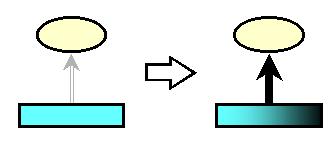 |
-
Introduce/enhance spatial order/structure in the spatial placement or structure of the Object(s).
-
Introduce (spatail) order of objects. [H8a. Order of objects]
-
IIncrease (spatail) order of objects. [H8b. Order of objects]
-
Decrease (spatail) order of objects. [H8c. Order of objects]
-
Remove (spatail) order of objects. [H8d. Order of objects]
-
Introduce shape-cahnge of an object. [H9a. Shape-change]
-
Prevent shape-change of an object. [H9b. Shape-change]
-
Introduce periodicity of patter (or inverse of spatial frequency). [H10a. Change periodicity of a pattern]
-
Increase periodicity of patter (or inverse of spatial frequency). [H10b. Change periodicity of a pattern]
-
Decrease periodicity of patter (or inverse of spatial frequency). [H10c. Change periodicity of a pattern]
-
Remove periodicity of patter (or inverse of spatial frequency). [H10d. Change periodicity of a pattern]
-
Super-pose objects (or unify objects). [H13a. Superpose/separate/differentiate objects]
-
Seperate objects. [H13b. Superpose/separate/differentiate objects]
-
Differentiate objects. [H13c. Superpose/separate/differentiate objects]
-
Introduce/enhance a space-related Attribute which has not been (or has been) utilized before.
-
Place one object inside another.[P7a. Nesting]
-
Instead of linear parts of the object, use curve parts. [P14a. Spheroidality]
-
Use rollers, balls, spirals. [P14b. Spheroidality]
-
Rearrange objects so that instead of one-storied arrangement a multi-storied arrangement can be achieved.[P17c. Another dimension]
-
Tilt the object.[P17d. Another dimension]
-
Use other side of the given area. [P17e. Another dimension]
-
Introduce spatial structure or inner-structure of Object(s) and vary the Attribute(s) (or the values of the Attribute(s)) depending on different places (or different parts of Object(s)).
-
Instead of uniform structure of your project, use non-uniform structure of the object. [P3a. Local quality]
-
Instead of uniform structure of environment, use non-uniform structure of the environment. [P3b. Local quality]
-
Use composite materials instead of uniform ones.[P40. Composites]
-
Introduce additives in concentrate at selected places. [S5-1.1.5 Introduction of substances under resticted conditions]
-
Symmetrical system ==> Partial asymmetry ==> Matched asymmetry [T8. Increasing asymmetry (to match external asymmetry)]
-
Many boundaries ==> Few boundaries ==> No boundaries [T9. Boundary breakdown]
-
Introduce periodicity of patter (or inverse of spatial frequency). [H10a. Change periodicity of a pattern]
-
Increase periodicity of patter (or inverse of spatial frequency). [H10b. Change periodicity of a pattern]
-
Decrease periodicity of patter (or inverse of spatial frequency). [H10c. Change periodicity of a pattern]
-
Remove periodicity of patter (or inverse of spatial frequency). [H10d. Change periodicity of a pattern]
-
Introduce symmetry. [H11a. Symmetry]
-
Increase symmetry. [H11b. Symmetry]
-
Decrease symmetry. [H11c. Symmetry]
-
Remove symmetry. [H11d. Symmetry]
-
Localize the problem. [H12a. Localize/delocalize the problem]
-
Delocalize the problem. [H12b. Localize/delocalize the problem]
-
Introduce/enhance the Attribute(s) related to the spatial motion of Object(s).
-
Make the movable part of your object fixed or the fixed part movable. [P13b. Other way round]
-
If your object is immobile, make it movable. [P15a. Dynamicity]
-
Increase the degree of free motion. [P15c. Dynamicity]
-
Make the system more flexible or movable. [S2-2.4 Evolution of SFM]
-
Make the system more flexible or adaptable for improving the efficiency of the F-SFMS. [S2-4.8 Complex-forced SFMS (F-SFMS)]
-
Point ==> 1D line ==> 2D plane ==> 3D surface [T10. Geometircal evolution (linear)]
-
Planar structure ==> 2D structure ==> Axi-symmetric structure --> Fully 3D structure [T11. Geometric evolution (volumetric)]
-
Immobile system ==> Jointed system ==> Full flexible system ==> Fluid or pneumatic system ==> Field based system [T12. Dynamization ]
(2e) Introduce/enhance a temporal Attribute or distribute/vary in time a harmful/useful Attribute or Attribute's value.
| Introduce/enhance the temporal Attribute(s) related to the operational phases, duration of operations, time frequency, etc. of the system, and depending on such temporal conditions activate different Attributes or vary the values of the Attributes in time. |
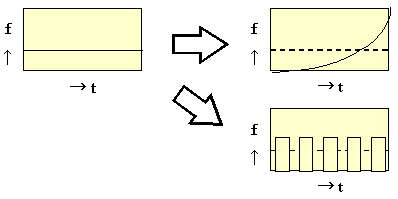 |
-
Introduce/enhance the temporal Attributes related to the operational phases, duration of operation, time frequency, etc. of the system.
-
Make your object or environment dynamically change in accord with the required conditions at each stage of operation. [P15d. Dynamicity]
-
Depending on various temporal conditions of the system, activate different Attribues or vary the values of the Attribute(s) at different times.
-
Activate different attributes in the same object at different times. [H1b. Unify out-of-phase functions]
-
Eliminate time (or variable --> constant). [H14a. Eliminate/introduce time]
-
Introduce time (or constant --> variant). [H14b. Eliminate/introduce time]
(2f) Change the phase, utilize the phase change, or change the inner-structure of the Object.
| Change the phase (i.e. state of condensation) of Object(s) , utilize the phase change, or introduce/change the inner structure at the micro level for using various Attributes thus activated/enhanced. |
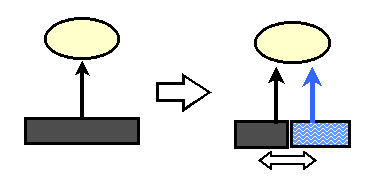 |
-
Change the phase (solid, liquid, gas, etc.) or the state of condensation of Object(s).
-
Instead of a solid object or its parts, use gases or liquids: inflatable and filled with liquids, air cushion, hydrostatic and hydro-dynamic. [P29. Pneumatic and hydraulic structures]
-
Change the object's aggregate state. [P35a. Change of physical and chemical parameters]
-
Monolithic solid ==> Segmented solid ==> Particulate solid ==> Fluid ==> Segmented fluid (Foam, aerosol) ==> Gas ==> Plasma ==> Field ==> Vacuum [T4. Object segmentation]
-
Utilize the phase change of the substance(s) of Object(s), and further utilize the physical effects involved by the phase change and also use special properties related to the coexistence of two phases.
-
Use physical phenomena accompanied by phase transitions: change of volume, emission or absorption of heat, etc. [P36a. Phase transitions]
-
Employ a phase transition for improving the effectiveness of the substance. [S5-3.1 Use of phase transitions]
-
Employ substances in which the phase transition occurs during the delivery of the useful function according to the operating conditions. [S5-3.2 Use of phase transitions]
-
Replace a single phase state with a dual phase state. [S5-3.4 Use of phase transitions]
-
Introduce physical or chemical interactions between the different phases of the system. [S5-3.5 Use of phase transitions]
-
Use reversible phase transitions to improve the functionality of the system. [S5-4.1 Use of physical effects]
-
Place the transforming substance at or close to its critical condition and make the input act as a trigger. [S5-4.2 Use of physical effects]
-
Introduce/enhance (heterogeneous or ordered) inner structure into the Object(s) (for example, by introducing voids and porous structure), and utilize new properties and Functions involved by the inner structure.
-
Make your object porous. [P31a. Porous materials]
-
Transition from solid substance to hollow to porous capillaries. [S2-2.3 Evolution of SFM]
-
Make uniform or dis-ordered substances into ones which are non-uniform and/or ordered in space and time. [S2-2.6 Evolution of SFM]
-
Introduce voids instead of substances. [S 5-1.1.1 Introduction of substances under resticted conditions]
-
Monolitic solid ==> Hollow structure ==> Structure with multiple hollows ==> Capillary/pporous structure ==> Porous structure with active elements [T2. Space segmentation]
-
Homogeneous sheet structure ==> 2D regular mesh structure ==> 3D fibre, alignment according to load conditions ==> Addition of active elements [T6. Webs and fibres]
-
Combine multiple materials (or substances) to compose a complex inner-structure matrial and introduce an Object with the material and use the new properties and Functions thus introduced.
-
If the object is porous, fill the pores with other substance, liquid or gas to achieve positive effect. [P31d. Porous materials]
-
Use composite materials instead of uniform ones. [P40. Composites]
-
Monolitic solid ==> Hollow structure ==> Structure with multiple hollows ==> Capillary/pporous structure ==> Porous structure with active elements[T2. Space segmentation]
(2g) Utilize Attribute(s)/properties at the micro level.
| Consider/design the structure/properties/interactions of Object(s) at the micrometer or nanometer (or even smaller) scale, and solve the problem from the micro-level principles. |
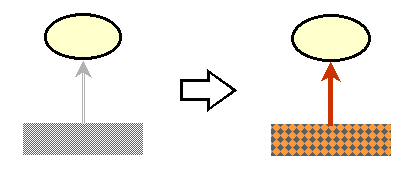 |
-
Instead of the ordinary macro scale, use the micrometer-, nanometer- or even smaller scale in space, consider the structures/properties/interactions of Object(s) in such a micro scale from their proper principles, and implement a system based on such observation for solving the problem.
-
Transition from the macro to the micro level. Look at S-Field at the micro level. [S3-2.1 Transition to microlevel]
-
102 ==> 101 ==> 100 ==> 10-1 ==> 10-2 ==> 10-3 ==> 10-4 ==> 10-5 ==> 10-6 ==> 10-7 ==> 10-8 ==> 10-9 ==> ... [T5. Evolution macro to nano scale (and beyond) (space)]
(2h) Improve the properties/performance of the system as a whole.
| (Besides the Attributes and Functions of the Objects as the components of the system,) consider the properties (or Attributes) and Functions of the system as a whole and improve them by designing/implementing/improving the system and its components. |
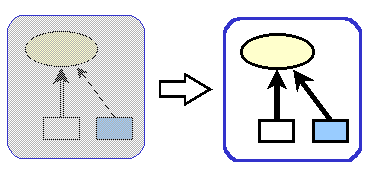 |
-
If the present system lacks some components to form a technical system even at its minimal level, introduce the missing Object(s) or Function(s) into the system to make it work as a technical system.
-
Construct a minimum S-Field Model system. [S1-1.1 Synthesis of SFMS]
-
Set the target of desirable properties and Functions of the system as a whole and design/implement/improve the system and its components so as to improve such properties and Functions. Some examples of the desirable properties and Functions of the system are:
- efficiency of the energy usage
- minimizing the human involvement and improving the intelligence
- ideality of the system (i.e., (principal useful function)/(mass + size + energy use + harmful functions)).
- robustness
- satisfaction of the market demands and customer requirements
-
If your object has to be lowered or raised, redesign the object's environment so that the necessity to raise or lower the object ceases. [P12. Equipotentiality]
-
Linear consideration of system ==> Partial accounting of non-linearities ==> Full accommodation of non-linealities [T15. (Matching to external) non-linearities]
-
Performance ==> Reliability ==> Convenience ==> Price [T23. Customer purchase focus]
-
Commodity ==> Product ==> Service ==> Experience => Transformation [T24. Market evolution]
-
Design optimized for single operating point ==> Design optimized at two operating points ==> Design optimized at several discrete operating points ==> Design re-optimized continuoously [T25. Design point]
-
Human ==> Human + tool ==> Human + powered tool ==> Human + semi-automated tool ==> Human + automated tool ==> Automated tool [T29. Reducing human involvement]
-
'Cut and try' ==> Steady-state design ==> Transient effects included ==> Solw degradation effects included ==> Cross-coupling effects ==> 'Design for Murphy' [T30. Design methodology]
-
etc. ==> Three energy conversions ==> Two energy conversions ==> One energy conversion ==> Zero energy conversion [T31. Reducing number of energy conversions (tending to zero)]
(3) Function Distribution Method
For the purpose of achieving/improving the principal useful Function of the system, distribute/rearrange various useful Functions (and some harmful Functions subsequently appearing) among the Objects which are already present, modified, or newly introduced into the system. Various Functions need to be transferred, divided, unified, or introduced. It is necessary to distribute/vary the Functions in a suitable way in space and in time, and further for better working of the system it is the key to utilize higher-level Functions for adapting/controlling etc.
(3a) Reassign the Function to a different Object.
| Reassign (or transfer) the present Function to a more suitable different Object which are already present or newly introduced in the system. |
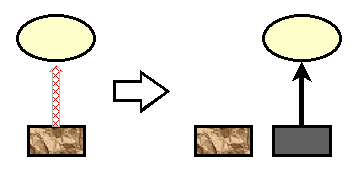 |
-
Find an insufficient/excessive/hamful Function of an Object in the system, and reassign (or transfer) the Function to a different Object (either already present or newly introduced) so as to make the Function effective/useful/non-harmful.
-
Take away an interfering part of your object. [P2a. Taking away]
-
Use an intermediate carrier to provide necessary actions if it is not possible to use existing objects or parts. [P24a. Intermediary]
-
Make use of a field that already exists in the environment. [S5-2.2 Introduction of fields under restricted conditions]
-
Replace the insufficient useful Function in the system with a similar but more effective and controllable Function probably based on a different physical principle. Accompanying this replacement of the Function, often the Objects and the Fields (i.e., physical interactions) relevant to the Function need to be replaced as a set.
-
Replace mechanical principle behind your system or object with another physical principle: optical, acoustic, magnetic, electromagnetic, thermal, etc. [P28. Mechanical principle replacement]
-
Instead of a solid object or its parts, use gases or liquids: inflatable and filled with liquids, air cushion, hydrostatic and hydro-dynamic. [P29. Pneumatic and hydraulic structures]
(3b) Divide the compound/multiple Functions and assign them to different Objects or different parts of an Object.
Divide the compound/multiple Functions present in the system and reassign the divided Functions to
different Objects (already present or newly introduced) or different parts of Objects. |
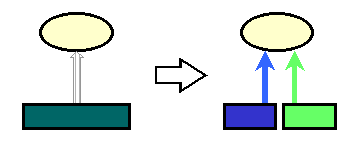 |
-
Divide the compound/multiple Functions (or non-separated multiple Functions) which are born by one Object, and assign the individual Functions to different Objects or different parts of Objects so as to let them work more effectively.
-
If two functions are to be performed by the same object but this causes problems, divide the object into two parts. [P3c. Local quality]
(3c) Unify multiple Functions and assign the unified Function to an Object.
| Unify multiple Functions of multiple Objects and assign the unified Function to one Object. |
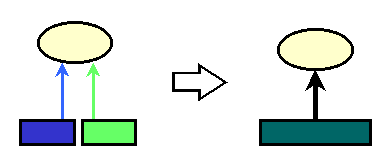 |
-
Unify multiple Functions presently born by multiple Objects and assign the unified Function to a new/modified (or compound) Object so as to perform the present Functions simultaneously. If any Object becomes redundant consequently, eliminate it.
-
If you have two objects which deliver different functions, design a new single object that would be capable of delivering both functions. [P6. Universality]
(3d) Introduce a new Function to assign to an Object.
| In order to achieve the target of the system or to solve the problem, introduce a new Function and assign it to an Object either present/modified or newly introduced. |
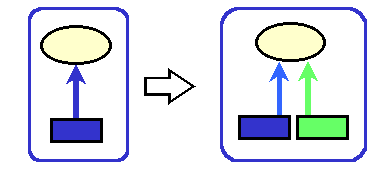 |
-
As for the source of the Function which is going to be introduced into the system (or into the component(s) of the system), guidelines are:
- Utilize the Field which is already present in other parts of the system or in the environment.
- Introduce a Field which can utilize or are cooperative/compatible with the properties of the Objects present in the system.
- Introduce new types of substances and a new Field as a set so as to implement a useful and effective Fnction.
- Introduce a new Function in such a way that it cooperates/enhances/complements/prevents/ protects/ensures/controls other Functions in the system.
-
Instead of actions defined perform opposite action.[P13a. Other way round]
-
Use harmful factors to achieve positive effects. [P22a. Turn the harm to one's good]
-
Apply a maximum action to the attached substance. [S1-1.7 Synthesis of SFMS]
-
Introduce a new field to neutralise the existing harmful effect. [S1-2.4 Decomposition of SFMS]
-
Introduce a new field. [S5-1.1.2 Introduction of substances under resticted conditions]
-
Make use of a field that already exists in the environment. [S5-2.2 Introduction of fields under restricted conditions]
-
Introduce fields for which the substances present in the system or external environment can act as media or sources. [S5-2.3 Introduction of fields under restricted conditions]
-
Use substances with special properties and add an associated field to use those properties. [S Mann Ce3 (D2)]
-
As for the types of Functions which are desirable to introduce, consider the following Functions categorized with the Fields (i.e., interactions/forces/energies/fields/etc.) in the sense of TRIZ, as guidelines:
- Functions related to the mechanical Fields,
- Functions related to the thermal Fields,
- Functions related to the electrical Fields,
- Functions related to the magnetic/electromagnetic Fields,
- Functions related to the optical Fields,
- Functions related to the chemical/biochemical Fields,
- Functions related to the visual/aural/tasting/smelling senses, etc.
-
Compensate for the weight of your object with merging it with another object that provides lifting force.[P8a. Counterweight]
-
Place your object into environment that provides aerodynamic, hydrodynamic or other lifting force.[P8b. Counterweight]
-
Use centrifugal forces. [P14d. Spheroidality]
-
Use ultrasonic frequencies.[P18d. Mechanical vibrations]
-
Use piezoelectric vibrators instead of mechanical ones. [P18e. Mechanical vibrations]
-
Use ultrasonic oscillations in combination with electromagnetic field. [P18f. Mechanical vibrations]
-
Use physical phenomena accompanied by phase transitions: change of volume, emission or absorption of heat, etc. [P36a. Phase transitions]
-
Use a ferro-magnetic substance and a magnetic field. [S2-4.1 Complex-forced SFMS (F-SFMS)]
-
Introduce physical or chemical interactions between the different phases of the system. [S5-3.5 Use of phase transitions]
-
No use of colour (monochrome) ==> Binary use of colour ==> Use of visible spectrum ==> Full spectrum use of colour [T21. Increasing use of colour]
-
Convert energy or information from one form to another; e.g., sensors/transducers. [H21. Transduction]
(3e) Distribute/vary the Function in space or utilize the spatial distribution/motion/vibration Function.
| Distribute/arrange the Function(s) in some spatial order/structure and increase the degree of spatial freedom. Utilize/enhance the spatial Function(s) of distributing/moving/vibrating the Object(s) (or the Attribute(s) of Object(s)). |
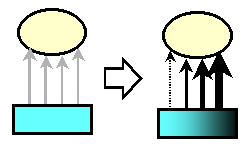 |
-
Concerning spatial positions where the Functions act, arrange the (multiple) Function(s) in the system in a spatial order/structure/variation so as to be able to work effectively, and increase the degree of freedom of the spatial arrangement, and further enable its temporal variation.
-
Make a uniform or disordered field into non-uniform and/or ordered fields in space and time. [S2-2.5 Evolution of SFM]
-
Make the field non-uniform and/or ordered in space and time for improving the efficiency of F-SFMS. [S2-4.9 Complex-forced SFMS (F-SFMS)]
-
Point ==> 1D line ==> 2D plane ==> 3D surface [T10. Geometircal evolution (linear)]
-
Planar structure ==> 2D structure ==> Axi-symmetric structure --> Fully 3D structure [T11. Geometric evolution (volumetric)]
-
1 degree of freedom ==> 2 degrees of freedom ==> 3 degrees of freedom ==> 4 degrees of freedom ==> 5 degrees of freedom ==> 6 degrees of freedom [T26. Degrees of freedom]
-
Introduce/enhance the Function(s) of spatially distributing/moving/transferring the Object(s).
-
Use rotary motion. [P14c. Spheroidality]
-
If your object moves along a line, consider movement within two-dimensional space. [P17a. Another dimension]
-
If your object moves in plane, consider movement within three-dimensional space. [P17b. Another dimension]
-
Tilt the object. [P17d. Another dimension]
-
Use the vibration of the Object(s), and further use resonance vibration and supersonic vibration.
-
Make your object or its part vibrate. [P18. Mechanical vibrations]
-
If the object is in oscillatory motion, increase the frequency of oscillations. [P18b. Mechanical vibrations]
-
Use resonance frequencies. [P18c. Mechanical vibrations]
-
Use ultrasonic frequencies.[P18d. Mechanical vibrations]
-
Use piezoelectric vibrators instead of mechanical ones. [P18e. Mechanical vibrations]
(3f) Distribute/vary the Function in time.
| Set the time (or timing) of operation of the Function(s) in an appropriate way. Set the timing of operation of a Function, in the sense of time period of operation (such as triggering event, operational conditions, etc.), temporal variation in the long time range, and temporal variation in the short time range (e.g., in pulses, in cycles, frequency, etc.), and also set the timing of multiple Functions in the sense of the sequential order, the relative timing of operations, etc. |
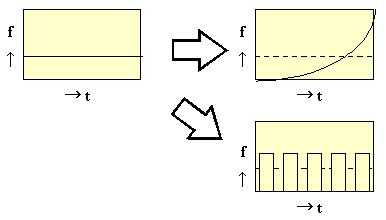 |
-
Distribute/vary the Function(s) in time.
-
Introduce a physical effect to turn off the ferromagnetic property. [S1-2.5 Decomposition of SFMS]
-
Make a uniform or disordered field into non-uniform and/or ordered fields in space and time. [S2-2.5 Evolution of SFM]
-
Make the field non-uniform and/or ordered in space and time for improving the efficiency of F-SFMS [S2-4.9 Complex-forced SFMS (F-SFMS)]
-
Match the rythms of the fields and substances in the F-SFMS. [S2-4.10 Complex-forced SFMS (F-SFMS)]
-
Activate different attributes in the same object at different times. [H1b. Unify out-of-phase functions]
-
If there is some problem in performing the principal Function in a simple way, perform a preparatory Function in advance, perform a protective Function in parallel on a temporary basis, or perform a post-Function afterwords. Also change/invert the order of performing the Functions.
-
If your object is subjected to harmful factor(s) of environment, subject it to antipodal action beforehand. This will compensate with the harmful factor. [P9a. Prior counteraction]
-
If your object has to be changed and this is hard to achieve, perform the required change of the object (fully or partially) beforehand. [P10b. Prior action]
-
If it is not possible to precisely achieve the required change, or to perform some action, reformulate the problem: how to make slightly less or slightly more and then achieve the required result.[P16. Partial or excessive action]
-
If your object is subjected to harmful or hazardous actions within some process, conduct the process at a very high speed.[P21. Skip]
-
Temporarily merge your object with another one that will provide the required action and then decompose them. [P24b. Intermediary]
-
Apply a maximum action and remove the surplus. [S1-1.6 Synthesis of SFMS]
-
Change sequence of events. [H2a. Sequence of events, H7ab. Initiation of event]
-
Reverse sequence of events. [H2b. Sequence of events, H7ab. Initiation of event]
-
Enable the Object(s) in the system to perform the desired Function(s) continuously (for a long period of time, even in varying situations).
-
All parts of the object must work continuously. [P20a. Useful action continuity]
-
Eliminate all idle running.[P20b. Useful action continuity]
-
Restore consumable parts of the object during operation. [P34b. Reject and regeneration of parts]
-
Perform the Function(s) at higher speed/rate, in pulses, or in periodical way. Perform the Function(s) in coordination with the resonance frequency of the system (or its part).
-
If the object is in oscillatory motion, increase the frequency of oscillations.[P18c. Mechanical vibrations]
-
Use resonance frequencies. [P18c. Mechanical vibrations]
-
Instead of continuous action use pulse actions. [P19a. Periodic action]
-
Vary periodicity according the conditions. [P19b. Periodic action]
-
Introduce rate of events. [H3a. Rate of events, H4abc. Periodicity]
-
Increase rate of events. [H3b. Rate of events, H4abc. Periodicity]
-
Decrease rate of events. [H3c. Rate of events, H4abc. Periodicity]
-
Remove rate of events. [H3d. Rate of events, H4abc. Periodicity]
-
Coordinate the timing of performing multiple Functions in a way to work cooperately at the same time, in sequence/cycle, or to work alternately for avoiding interference.
-
Use pauses between impulses to perform some other action. [P 19c. Periodic action]
-
Match the frequency of the field to the natural frequency of the Product/Tool. [S2-3.1 Evolution by coordinating rhythms]
-
Match the frequencies of multiple fields in use. [S2-3.2 Evolution by coordinating rhythms]
-
For two incompatibel actions, perform one action during pauses in the other. [S2-3.3 Evolution by coordinating rhythms]
-
Multiplex sequence of events. [H2c. Sequence of events]
(3g) Realize the detection/measurement Function.
| Perform the detection/measurement Function as simply and quickly as possible (especially, make the detection/measurement itself unnecessary, if possible) and by using Attributes sensitive and accurate for detection/measurement. [See (3h) also.] |
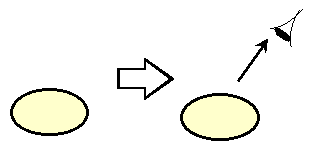 |
-
Modify the system to make the detection or measurement unnecessary. [S4-1.1 Change instead of measurment and detection]
-
Make the detection or measurement on a copy of the object. [S4-1.2 Change instead of measurment and detection]
-
Transform the problem into one involving successive measurement of changes. [S4-1.3 Change instead of measurment and detection]
-
1 sense ==> 2 senses ==> 3 senses ==> 4 senses ==> 5 senses [T20. Increased use of senses]
(3h) Introduce/enhance the adapting/coordination/control Function.
| Introduce/enhance Function(s) for adapting/coordinating/controlling the system and make the system higher and more intelligent. |
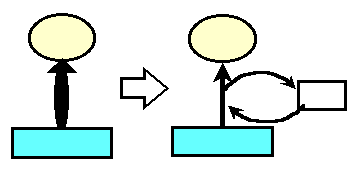 |
-
Reduce the human involvement in the system as a basic step of improvement.
-
Human ==> Human + tool ==> Human + powered tool ==> Human + semi-automated tool ==> Human + automated tool ==> Automated tool [T29. Reducing human involvement]
-
Introduce (or replace with) a Field easier to controll in the system.
-
Add a second, more controllable S-Field. [S2-1.2 Transition to complex SFMS]
-
Replace an uncontrolled field with a more controllable one. [S2-2.1 Evolution of SFM]
-
Form an electro-magnetic SFMS [S2-4.11 Complex-forced SFMS (F-SFMS)]
-
Introduce an ER fluid to form an electro-magnetic FSMS. [S2-4.12 Complex-forced SFMS (F-SFMS)]
-
Repalce the Object with the one made of materials adaptable or easier to control.
-
Passive material ==> One-way adaptive material ==> Two-way adaptive material ==> Fully adaptive material [T1. Smart materials]
-
Make use of physical effects associated with the magnetic substances for better control. [S2-4.7 Complex-forced SFMS (F-SFMS)]
-
Set the substance in selected places so that the Function is applied adaptively onto the selected places.
-
Introduce a protective substance for achieving a selective action. [S1-1.8.1 Synthesis of SFMS]
-
ntroduce a substance for selective enhancement of an action. [S1-1.8.2 Synthesis of SFMS]
-
Place the transforming substance at or close to its critical condition and make the input act as a trigger. [S5-4.2 Use of physical effects]
-
Coordinate the timing and Functions of system operation.
-
Non co-ordinated action ==> Partially co-ordinated action ==> Fully co-ordinated action ==> Different actions during intervals [T13. Action co-ordination, T14. Rhythm co-ordination]
-
Synchronize events. [H6a. Synchronization/out-of-phase/differentiate events]
-
Out-of-phase events. (or histeresis) [H6b. Synchronization/out-of-phase/differentiate events]
-
Differentiate events. [H6c. Synchronization/out-of-phase/differentiate events]
-
Introduce/enhance the feedback system or other coordination/control mechanism in order to coordinate and control the Functions in the system.
-
Introduce feedback. [P23a. Feedback]
-
If the feedback is available, vary it in accord with operating conditions. [P23b. Feedback]
-
Transform a substance of the current system into an independently controllable S-Field. [S2-1.1 Transition to complex SFMS]
-
Linear consideration of system ==> Partial accounting of non-linearities ==> Full accommodation of non-linealities [T15. (Matching to external) non-linearities]
-
Direct control action ==> Action through intermediary ==> Addition of feedback ==> Intelligent feedback [T28. Controllability]
-
Introduce feed-back. [H5a. Feed-back]
-
Increase feed-back. [H5b. Feed-back]
-
Decrease feed-back. [H5c. Feed-back]
-
Remove feed-back. [H5d. Feed-back]
-
Implement the Function of coordinating/adjusting the actions of the Objects by themselves or repairing the Objects by themselves, in a way of self-service.
-
The object must serve itself by performing tuning, adjusting and repair operations itself. [P25a. Self-service]
-
Restore consumable parts of the object during operation. [P34b. Reject and regeneration of parts]
(3i) Achieve the Function with different physical principle.
| In place of the present Function (especially the one achieved by gravitational or mechanical principles), achieve the similar Function in a more effective and controllable way on the basis of a different physical principle. |
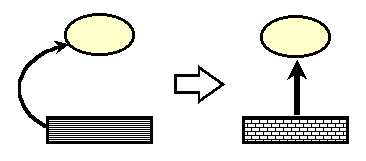 |
-
Replace mechanical principle behind your system or object with another physical principle: optical, acoustic, magnetic, electromagnetic, thermal, etc. [P28. Mechanical principle replacement]
-
Instead of a solid object or its parts, use gases or liquids: inflatable and filled with liquids, air cushion, hydrostatic and hydro-dynamic.[P29. Pneumatic and hydraulic structures]
(4) Solution Combination Method
Combine multiple solutions (or multiple elements of solutions) in various ways (such as functionally, spatially, temporally, structurally, at the principle level, etc.) so as to form a new solution which enhances the strong points, complements the drawbacks, and overcomes the contradictions. Also solve the problem by transferring to the super-system level.
(4a) Combine solutions functionally.
| Combine multiple solutions by linking their Functions. Especially, combine multiple solutions by linking Functions which are related in causal relationships or by combining Functions which are complementary or contrary with one another. |
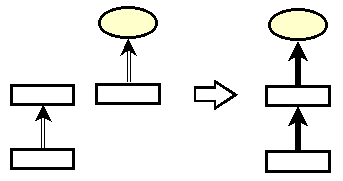 |
-
Combine multiple solutions having Functions in sequence in the causal relationship and form a better solution by performing the Functions in sequence in time.
-
If it is not possible to precisely achieve the required change, or to perform some action, reformulate the problem: how to make slightly less or slightly more and then achieve the required result.[P16. Partial or excessive action]
-
Use available resources or waste resources. [P25b. Self-service]
-
Apply a maximum action and remove the surplus. [S1-1.6 Synthesis of SFMS]
-
Make the detection or measurement on a copy of the object. [S4-1.2 Change instead of measurment and detection]
-
Combine multiple solutions having Functions in sequence in the causal relationship and form a better solution by performing the Functions simultaneously so that one Function extends/enhances/suppresses/protects/etc. the other.
-
Use ultrasonic oscillations in combination with electromagnetic field. [P18f. Mechanical vibrations]
-
Use harmful factors to achieve positive effects.[P22a. Turn the harm to one's good]
-
Introduce a protective substance for achieving a selective action. [S1-1.8.1 Synthesis of SFMS]
-
Introduce a substance for selective enhancement of an action. [S1-1.8.2 Synthesis of SFMS]
-
Enhance an existing or add a new field to provide an easily detectable parameter related to the parameter required to be measured or detected. [S4-2.1 Synthesis of measurement system]
-
Make use of physical, chemical or biological effects. [S4-3.1 Improvement of measurement systems]
-
Use resonance in all or part of the system and detect the change in the resonance frequency. [S4-3.2 Improvement of measurement systems]
-
Combine multiple solutions having complementary or contrary Functions and form a better solution by implementing the Functions in different parts of the system or by implementing the Functions after unification.
-
If two functions are to be performed by the same object but this causes problems, divide the object into two parts. [P3c. Local quality]
-
If you have two objects which deliver different functions, design a new single object that would be capable of delivering both functions.[P6. Universality]
-
Non co-ordinated action ==> Partially co-ordinated action ==> Fully co-ordinated action ==> Different actions during intervals [T13. Action co-ordination ]
-
Combine multiple solutions and form a better solution by implementing a functional hierarchical structure containing adapting/controlling/learning mechanism.
-
Introduce a physical effect to turn off the ferromagnetic property. [S1-2.5 Decomposition of SFMS]
-
Transform a substance of the current system into an independently controllable S-Field. [S2-1.1 Transition to complex SFMS]
-
Add a second, more controllable S-Field. [S2-1.2 Transition to complex SFMS]
-
Form an electro-magnetic SFMS. [S2-4.11 Complex-forced SFMS (F-SFMS)]
-
Introduce an ER fluid to form an electro-magnetic FSMS. [S2-4.12 Complex-forced SFMS (F-SFMS)]
(4b) Combine solutions spatially.
| Combine multiple solutions in respect to the spatial positions to apply; for instance, at different places (for avoiding the mutual interferrence), at distributed places, side by side, in front and back (in sequence), on top and bottom, at the same place alternatively, inside of the other, as an inner-structure of the other, etc. |
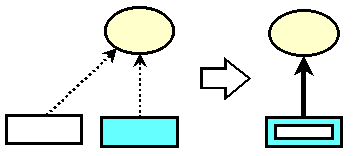 |
-
Place one object inside another. [P7a. Nesting]
-
Make one object dynamically pass through a cavity of another object when necessary. [P7c. Nesting]
-
If your object has to be lowered or raised, redesign the object's environment so that the necessity to raise or lower the object ceases. [P12. Equipotentiality]
-
Rearrange objects so that instead of one-storied arrangement a multi-storied arrangement can be achieved.[P17c. Another dimension]
-
Use other side of the given area. [P17e. Another dimension]
-
If the object is porous, fill the pores with other substance, liquid or gas to achieve positive effect. [P31d. Porous materials]
-
Monolitic solid ==> Hollow structure ==> Structure with multiple hollows ==> Capillary/pporous structure ==> Porous structure with active elements [T2. Space segmentation]
-
Smooth surface ==> Surface with rib protrusions ==> 3D roughened surface ==> Roughened surface + active pores [T3. Surface segmentation]
-
Super-pose objects (or unify objects). [H13a. Superpose/separate/differentiate objects]
-
Seperate objects. [H13b. Superpose/separate/differentiate objects]
-
Differentiate objects. [H13c. Superpose/separate/differentiate objects]
(4c) Combine solutions temporally.
| Combine multiple solutions in respect to time to apply; for instance, in sequence (one after another), beforehand of the other, simultaneously (in parallel), afterwards of the other, in the reverse order, alternatively, in pulses, periodically, from time to time, interrupting/switching corresponding to the situations, etc. |
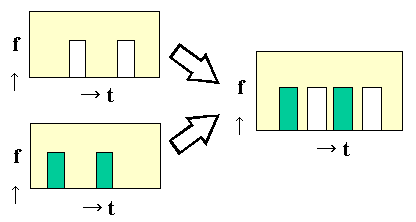 |
-
Perform one Function (of one solution) beforehand as a preceeding process for doing the other (principal) Function (of the other solution).
-
If your object is subjected to harmful factor(s) of environment, subject it to antipodal action beforehand. This will compensate with the harmful factor.[P9a. Prior counteraction]
-
If your object is subjected to harmful factors of environment, create conditions that will prevent the object from harmful factors beforehand. [P10a. Prior action]
-
If your object has to be changed and this is hard to achieve, perform the required change of the object (fully or partially) beforehand. [P10b. Prior action]
-
If your object is unreliable, create conditions in advance that will prevent the object.[P11. Early cushioning]
-
Perform one Function (of one solutions) afterwards as a post-process for doing the other (principal) Function (of the other solution).
-
If a part of an object that has delivered its function had become unnecessary or undesired, elimenate it by dissolving, evaporating, etc. or modify so that the interfering property will cease to exist. [P34a. Reject and regeneration of parts]
-
Introduce a substance which can be decomposed later. [S5-1.1.8 Introduction of substances under resticted conditions]
-
Perform multiple Functions of multiple solutions at the same time in parallel (or alternatingly).
-
Use pauses between impulses to perform some other action. [P19c .Periodic action]
-
Restore consumable parts of the object during operation. [P34b. Reject and regeneration of parts]
-
Continuous action ==> Periodic action ==> Use of resonance ==> travelling wave [T14. Rhythm co-ordination]
-
Combine multiple solutions so as to perform them alternatively by switching them dynamically corresponding the surrounding situations.
-
Make your object or environment dynamically change in accord with the required conditions at each stage of operation. [P15d. Dynamicity]
(4d) Combine solutions structurally.
| Combine multiple solutions by forming a (hierarchical) functional structure in such a way that the solutions are performed alternatively under different conditions or performed at different levles. |
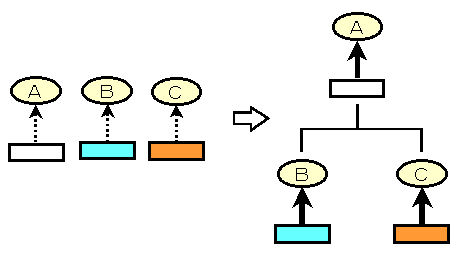 |
-
Combine multiple solutions so as to perform them alternatively under different conditions.
-
Redesign your object and environment so that each part of the object must be in conditions proper for operation.[P3d. Local quality]
-
Make your object or environment dynamically change in accord with the required conditions at each stage of operation. [P15d. Dynamicity]
-
Design optimized for single operating point ==> Design optimized at two operating points ==> Design optimized at several discrete operating points ==> Design re-optimized continuoously [T25. Design point]
-
'Cut and try' ==> Steady-state design ==> Transient effects included ==> Solw degradation effects included ==> Cross-coupling effects ==> 'Design for Murphy' [T30. Design methodology]
-
Combine multiple solutions so as to perform them at different levels (such as the whole system level and the subsystem level).
-
Distribute incompatible and/or ‘opposite’ properties among the system and its parts. [S3-1.5 Transitions to bisystem and polysystem]
(4e) Combine solutions at the principle level.
| Combine multiple solutions based on different principles and form a solution in various ways; for instance, as a temporary solution in the transient stage, in a hybrid system, in a compromise, to back-up the other, to perform on a background of the other, etc. |
 |
-
Replace mechanical principle behind your system or object with another physical principle: optical, acoustic, magnetic, electromagnetic, thermal, etc. [P28. Mechanical principle replacement]
-
Human ==> Human + tool ==> Human + powered tool ==> Human + semi-automated tool ==> Human + automated tool ==> Automated tool [T29. Reducing human involvement]
-
Invoke contradiction, examine opposites. [H16. Invoke contradiction/examine opposites]
-
Simplify the problem. [H20a. Simplify/complex]
-
Complex the problem. [H20b. Simplify/complex]
(4f) Combine solutions at the super-system level.
| Consider the higher-level purpose or principal function which should be performed by the system in the problem and solve the current problem by combining/coordinating the present system with the neighboring system(s) and forming/improving the higher-level system (i.e. the super-system). |
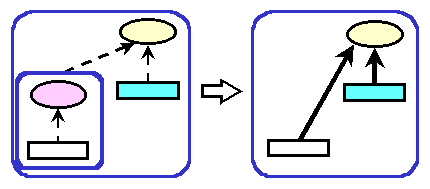 |
-
Transform a substance of the current system into an independently controllable S-Field. [S2-1.1 Transition to complex SFMS]
-
Combine the system with another to form a bi- or poly- system. [S3-1.1 Transitions to bisystem and polysystem]
-
Increase/improve the links between the elements in the bi- or poly- system. [S3-1.2 Transitions to bisystem and polysystem]
-
Increase the differences between system components in the bi- or po;y- system. [S3-1.3 Transitions to bisystem and polysystem]
-
Integrate systems and reduce auxiliary components in the bi- or poly- system. [S3-1.4 Transitions to bisystem and polysystem]
(5) Solution Generalization Method
Represent a solution in a more general way, form a solution template, and obtain concepts of solutions in the associative manner. Also generate a hierarchical system of solutions.
(5a) Generalize/specify the solution for associative thinking.
| Replace the technical/specific terms in a solution with plain/generic terms, form a plain solution template, and then obtain new specific conceptual solutions in an associative way. |
 |
-
Genericize object's functions to discover uniqueness. [H18a. Genericize object's functions]
-
Genericize object's functions to discover replacement objects. [H18b. Genericize object's functions]
-
Genericize solutions to become templates for other solutions. [H19. Genericize solutions]
(5b) Construct a hierarchical system of solutions.
| Classify a number of solutions obtained so far, make a hierachical system of solutions with respect to the levels of generalization, consider the overall view of the solution space, and try a comprehensive search of solutions. |
 |
Notes of Symbols for Illustrations:

Objects: Oval: Object, especially Target Object which is affected by the Function.
Rectangles: Objects, especially Tool Objects which act with the Function.
Attributes: Attributes are sorts (or categories, and not values) of properties of Objects.
Shown with different colors and patterns for each object.
The patterns in the above figures intend: Solid, Powder, Liquid, Gas,
Hazardous, Varying in space, and Micro-level properties of Objects..
Functions: Shown with different styles of arrows.
solid arrow: useful Function
broken-line arrow: (useful but) insufficient Function
fat arrow: excessive (and hence rather harmful) Function
crossed arrow: harmful Function
Three different patterns of arrows for showing different Functions.
Solutions: Shown with round-cornered rectangles.
Last updated on Apr. 3, 2003. [Note added: Dec. 22, 2012] Access point: Editor: nakagawa@ogu.ac.jp

































